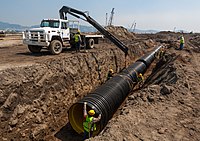
Photo from wikipedia
Lakes represent as much as ∼25% of the total land surface area in lowland permafrost regions. Though decreasing lake area has become a widespread phenomenon in permafrost regions, our ability… Click to show full abstract
Lakes represent as much as ∼25% of the total land surface area in lowland permafrost regions. Though decreasing lake area has become a widespread phenomenon in permafrost regions, our ability to forecast future patterns of lake drainage spanning gradients of space and time remain limited. Here, we modeled the drivers of gradual (steady declining lake area) and catastrophic (temporally abrupt decrease in lake area) lake drainage using 45 years of Landsat observations (i.e. 1975–2019) across 32 690 lakes spanning climate and environmental gradients across northern Alaska. We mapped lake area using supervised support vector machine classifiers and object based image analyses using five-year Landsat image composites spanning 388 968 km2. Drivers of lake drainage were determined with boosted regression tree models, using both static (e.g. lake morphology, proximity to drainage gradient) and dynamic predictor variables (e.g. temperature, precipitation, wildfire). Over the past 45 years, gradual drainage decreased lake area between 10% and 16%, but rates varied over time as the 1990s recorded the highest rates of gradual lake area losses associated with warm periods. Interestingly, the number of catastrophically drained lakes progressively decreased at a rate of ∼37% decade−1 from 1975–1979 (102–273 lakes draining year−1) to 2010–2014 (3–8 lakes draining year−1). However this 40 year negative trend was reversed during the most recent time-period (2015–2019), with observations of catastrophic drainage among the highest on record (i.e. 100–250 lakes draining year−1), the majority of which occurred in northwestern Alaska. Gradual drainage processes were driven by lake morphology, summer air and lake temperature, snow cover, active layer depth, and the thermokarst lake settlement index (R 2 adj = 0.42, CV = 0.35, p < 0.0001), whereas, catastrophic drainage was driven by the thawing season length, total precipitation, permafrost thickness, and lake temperature (R 2 adj = 0.75, CV = 0.67, p < 0.0001). Models forecast a continued decline in lake area across northern Alaska by 15%–21% by 2050. However these estimates are conservative, as the anticipated amplitude of future climate change were well-beyond historical variability and thus insufficient to forecast abrupt ‘catastrophic’ drainage processes. Results highlight the urgency to understand the potential ecological responses and feedbacks linked with ongoing Arctic landscape reorganization.
Journal Title: Environmental Research Letters
Year Published: 2021
Link to full text (if available)
Share on Social Media: Sign Up to like & get
recommendations!